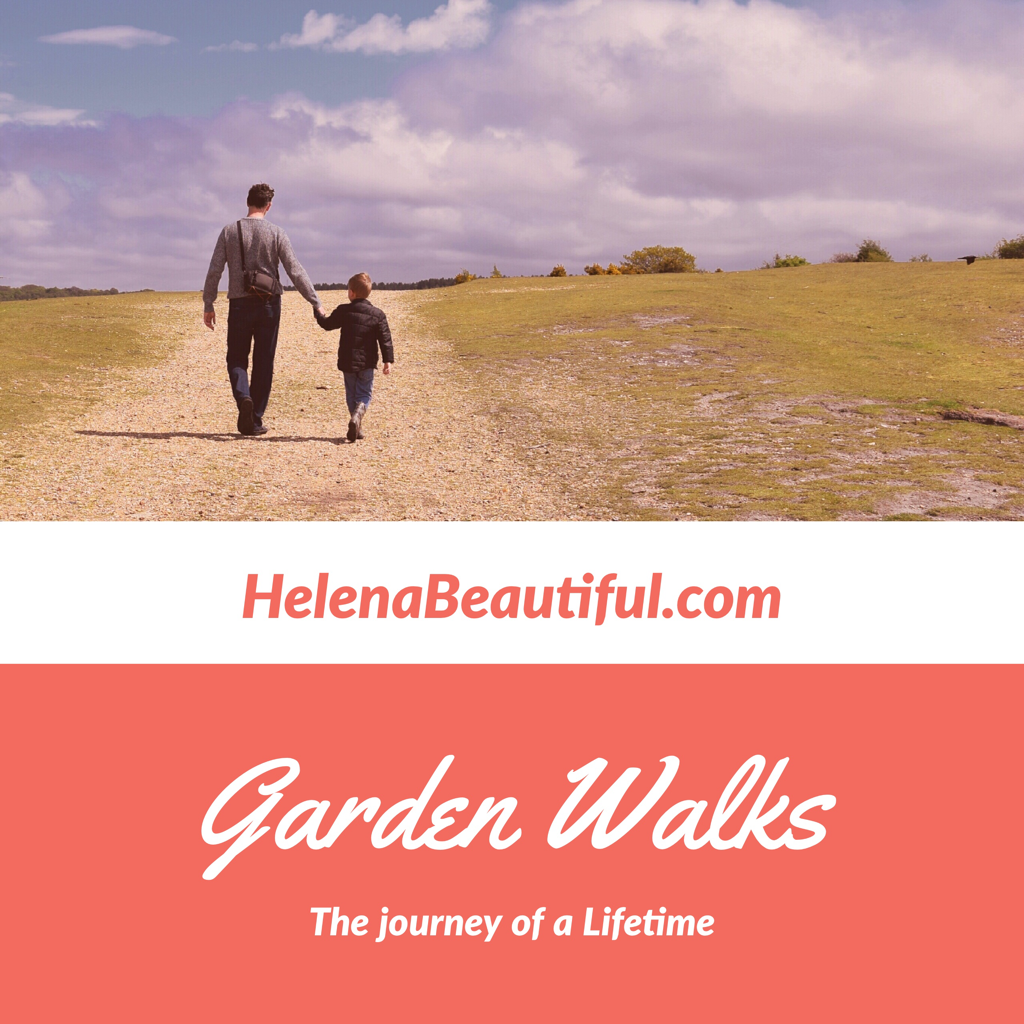Garden Walks - The Journey of a Lifetime
By: Chris VanCleave, Chairman Helena Beautification Board
Instinctively, I think some people are drawn to the earth
I never thought of myself as an early riser. Actually, I used to cringe under my pillow as a boy when my dad would rise at 4 a.m. to prepare for the day. He always rattled around in the kitchen making a goliath-sized bowl of grits and a simmering pot of fresh brewed coffee. The rattling was his way of trying to rouse me up to spend some time with him. Sadly, more often than not, I would remain in bed.
His morning routine was predictable in the months of summer: a full pot of coffee, breakfast, a garden walk, and then he was off to work. My dad loved his vegetable garden. He grew big juicy “Better Boy” tomatoes, sweet smelling cantaloupes, crisp cucumbers, dark green zucchini, spring lettuce, radishes and carrots. He would walk the garden performing any number of tasks that the circumstance demanded; gathering the harvest, pulling weeds, suckering tomato plants, applying SEVIN dust, watering, fertilizing, etc. He cared about his garden. He loved to watch things grow. These garden walks were essential to the health of his garden and a key to his own happiness. He was a better person for having walked his garden each day.
Tragically, my dad never lived to see my gardening endeavors. He was killed in a senseless automobile accident when I was 12. His departure left a gaping hole in my life and for years we struggled to piece our lives back together. Our garden and our gardener were gone. Time marches on. I grew up, married, had children and now have a garden of my own to tend. Now, I am the one up each morning at 5:00 a.m., rattling around to make coffee then grabbing my camera and pruners. I am out the door each day for my morning garden walk. We don’t grow vegetables. We grow flowers, in particular roses. We now cultivate over 80 varieties. The roses are all mixed in with an assortment of annuals and perennials that enrich our lives in many ways. My walks, like my dad’s are filled with activity. I write and lecture about my rose gardening adventures, so I snap pictures of the best blooms, deadhead spent ones, pull weeds, spray for pests or disease, pray for rain or my favorite activity, collecting blooms to share with friends and family and as a lifetime learner, soak in the knowledge that all gardens have to offer. Then, as now the garden has become a place of hope and healing.
When I look back at those years with my dad, I remember our final garden walk together, just two days before he was killed. We talked about how next year we would plant pumpkins and that it was time to turn the garden under for its winter rest. His words were filled with promise and hope. Gardeners live on the promise of “next year.” It’s the hope of things to come. It wasn't too long ago that my own son and I worked in the garden together. He helped me construct three raised beds for new roses. He’s not much of a gardener or an early riser, but I’m working on him. Life has come full circle.
Instinctively, I think some people are drawn to the earth. Gardens are indeed a place of hope and healing. There isn't much I can't reason out in my mind by working in the garden. According to a recent article from the National Gardening Bureau, there are a few design elements that will turn any space in to a place of healing and inspiration.
For many Alabama gardeners, the decision to get out in the garden, put your hands in the dirt and grow something is as much a part of who we are as what football team we cheer for. It’s an essential part of life. Gardening feeds us physically, mentally, spiritually and without our gardens, we would fail to live up to our full potential.
His morning routine was predictable in the months of summer: a full pot of coffee, breakfast, a garden walk, and then he was off to work. My dad loved his vegetable garden. He grew big juicy “Better Boy” tomatoes, sweet smelling cantaloupes, crisp cucumbers, dark green zucchini, spring lettuce, radishes and carrots. He would walk the garden performing any number of tasks that the circumstance demanded; gathering the harvest, pulling weeds, suckering tomato plants, applying SEVIN dust, watering, fertilizing, etc. He cared about his garden. He loved to watch things grow. These garden walks were essential to the health of his garden and a key to his own happiness. He was a better person for having walked his garden each day.
Tragically, my dad never lived to see my gardening endeavors. He was killed in a senseless automobile accident when I was 12. His departure left a gaping hole in my life and for years we struggled to piece our lives back together. Our garden and our gardener were gone. Time marches on. I grew up, married, had children and now have a garden of my own to tend. Now, I am the one up each morning at 5:00 a.m., rattling around to make coffee then grabbing my camera and pruners. I am out the door each day for my morning garden walk. We don’t grow vegetables. We grow flowers, in particular roses. We now cultivate over 80 varieties. The roses are all mixed in with an assortment of annuals and perennials that enrich our lives in many ways. My walks, like my dad’s are filled with activity. I write and lecture about my rose gardening adventures, so I snap pictures of the best blooms, deadhead spent ones, pull weeds, spray for pests or disease, pray for rain or my favorite activity, collecting blooms to share with friends and family and as a lifetime learner, soak in the knowledge that all gardens have to offer. Then, as now the garden has become a place of hope and healing.
When I look back at those years with my dad, I remember our final garden walk together, just two days before he was killed. We talked about how next year we would plant pumpkins and that it was time to turn the garden under for its winter rest. His words were filled with promise and hope. Gardeners live on the promise of “next year.” It’s the hope of things to come. It wasn't too long ago that my own son and I worked in the garden together. He helped me construct three raised beds for new roses. He’s not much of a gardener or an early riser, but I’m working on him. Life has come full circle.
Instinctively, I think some people are drawn to the earth. Gardens are indeed a place of hope and healing. There isn't much I can't reason out in my mind by working in the garden. According to a recent article from the National Gardening Bureau, there are a few design elements that will turn any space in to a place of healing and inspiration.
- Grow plants that you find pleasing. Are you energized by bright colors? Then include annuals such as zinnias, petunias, sunflowers or cosmos. If you enjoy cooking, incorporate herbs, vegetables, and edible flowers into your garden. Plants such as sage or lavender can be harvested and used for aromatherapy.
- Include a place to sit and observe the beauty of nature or a path for walking through the garden. Enclose it with shrubs or fencing to create a secluded retreat.
- Add a focal point for meditation and reflection such as a piece of sculpture, a special plant, interesting rocks, wind chimes or a water fountain.
- Encourage butterflies, birds, insects and other wildlife to the garden for their healing energy. Birdfeeders and birdhouses quickly and easily begin attracting garden visitors. Choose plants that supply nectar and food including coneflowers (Echinacea purpurea), butterfly flower (Aesclepias tuberosa) salvias (Salvia spp.), dill, parsley, and sunflowers. (Source: Why & How To Create A Healing Garden)
For many Alabama gardeners, the decision to get out in the garden, put your hands in the dirt and grow something is as much a part of who we are as what football team we cheer for. It’s an essential part of life. Gardening feeds us physically, mentally, spiritually and without our gardens, we would fail to live up to our full potential.

Nicknamed "The Redneck Rosarian", Chris VanCleave is passionate about gardening and growing roses. He is an active member of the Birmingham chapter of the American Rose Society, serving two terms as President. In 2007, he created the Rose Chat Podcast which has reached over a half a million listeners with news and information on growing the world's most beloved flower, the rose. He was a contributor to the 2015 Southern Living Gardening Book, has appeared on P. Allen Smith's Garden Home television show and was featured in the June 2015 issue of Southern Living Magazine. Locally, Chris serves as Chairman of the Helena Beautification Board where he has spearheaded efforts to create a sustainable landscape in one of the Top 100 places to live in the US. His writing is seen on About.com, HGTV, Home Depot Gardening Club and on his popular website; RedneckRosarian.com, where he chronicles his gardening adventures and explores an intrinsic mix of life, faith and gardening. An agent of change with over 20 years' experience in process innovation, Mr. VanCleave is leading the charge to reinvigorate horticulture societies and helping them to reach their full potential in the social media age.

